Novel Ultrafast Sources From THz to X-Rays
Ultrafast source development has been crucial to a wide range of applications, including, but not limited to: astrocombs, laser ablation for surgery and manufacturing, femtochemistry, attosecond science, and, more recently, compact accelerators. In the Ultrafast Optics and X-Rays Group at MIT we are actively exploring novel ultrafast sources that span from the visible into the THz range. These include: on-chip mode-locked oscillators, OPA and OPCPA few-cycle sources, and high-field, few-cycle THz generation.
The articles linked below provide a snapshot of recent source-development projects in the group.
- Novel Mid-IR Sources for High-Harmonic Generation in Gases and Solids
- High-Field THz Generation and Applications
Novel Mid-IR Sources for High-Harmonic Generation in Gases and Solids
High-energy phase-stable femtosecond mid-infrared (mid-IR) pulses can provide unique opportunities to explore phase-sensitive strong-field light-matter interactions in atoms, molecules and solids. Since the ponderomotive energy of a laser field is scaled with the drive wavelength squared, a mid-IR wavelength is much more efficient than a near-IR wavelength for driving strong-field interactions, which allows the sub-cycle control of high-energy electrons and their emissions. For example, a mid-IR wavelength of ~2 mm can extend the cutoff photon energy into the water-window soft X-ray range (280-540 eV or 2.3-4.4 nm) from high-harmonic generation (HHG) in neon and helium gases. The HHG-based coherent soft X-rays are an essential source for attosecond science and coherent X-ray imaging. Moreover, at the mid-IR wavelength, Keldysh parameter (inversely proportional to the ponderomotive potential) could be much smaller than unity even at relatively modest laser intensities, enabling the HHG in solids without damage. Recently, there have been enormous efforts about the solid-state HHG as a path for petahertz electronics. The electron dynamics within the band structure of solids is being revealed by studying the intraband and interband HHG mechanisms.
Our group has been developing novel mid-IR sources for HHG and attosecond science applications. Fig. 1(a) shows the recent demonstration [1] of water-window soft X-ray HHG in neon driven by a high-energy 2.1 mm source based on an optical parametric chirped-pulse amplifier (OPCPA) [2]. The cutoff energy was extended up to 450 eV and the photon flux of ~106 photons/s/1% bandwidth at 407 eV of nitrogen K-edge. We also obtained ~2×108 photons/s/1% bandwidth at 160 eV from HHG in argon [2]. The simulation in the inset of Fig. 1(b) confirms the generation of attosecond pulse train. This HHG-based water-window X-ray source can be used for time-resolved carbon and nitrogen K-edge absorption spectroscopy [3] as well as soft X-ray attosecond streaking for attosecond pulse measurements [4].
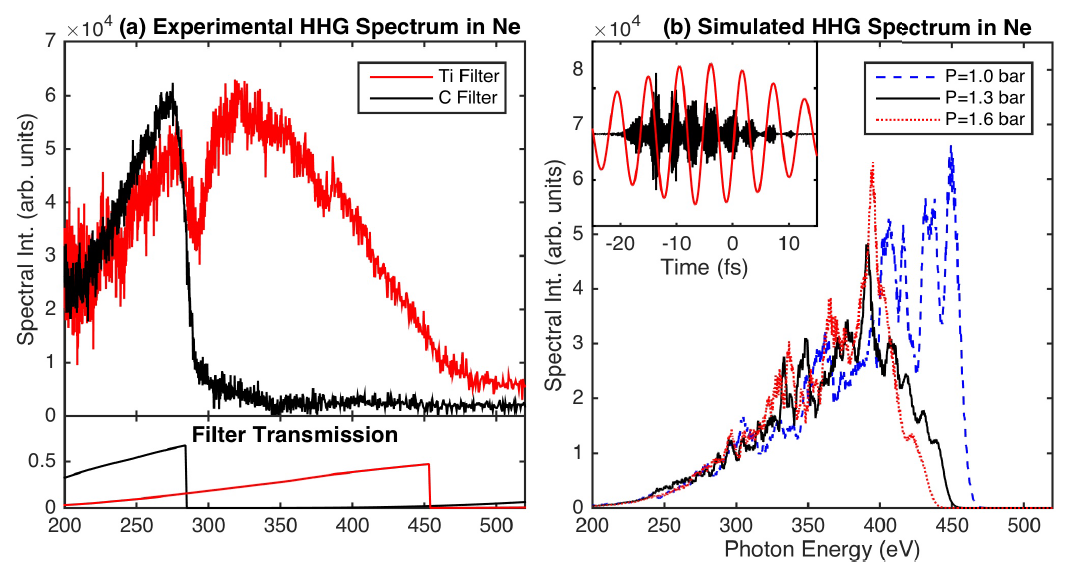
Fig. 1 Water-window soft X-ray HHG demonstration (a) and simulation (b) in neon driven by a mid-IR driver.
Mid-IR wavelengths longer than ~2 mm are even more interesting for both ~keV HHG in gases [5] and HHG in low-band gap solids [6]. A high-power ultrafast 2.1 mm source can serve as an excellent pump source for mid-IR optical parametric amplifier (OPA) or OPCPA at the 3-15 mm range using non-oxide crystals such as CdSiP (CSP), ZnGeP2 (ZGP) and GaSe. We recently demonstrated a high-energy sub-cycle pulse synthesizer based on a mid-IR OPA and generated high-harmonics in solids [7]. The OPA’s signal and idler combined spectrum spans from 2.5 to 9.0 µm. We coherently synthesize the passively carrier-envelope phase (CEP)-stable signal and idler pulses to generate 33 mJ, 0.88-cycle, multi-GW pulses centred at ~4.2 mm, which is further energy scalable. The measured spectrum and temporal profiles are shown in Figs. 2(a) and (b). The mid-IR sub-cycle pulse is used for driving high-harmonic generation in thin silicon (direct bandgap of 2.58 eV) samples. The HHG spectra driven by few-cycle mid-IR pulses and sub-cycle mid-IR pulses are shown in Figs. 2(c)-(f). We produced harmonics up to ~19th order with a continuous spectral coverage due to the isolated emission by the sub-cycle driver, demonstrating the feasibility of controlling isolated petahertz electron dynamics in solids, for the first time. We plan to demonstrate the CEP-sensitive isolated sub-cycle electron dynamics along with time-domain studies. Our novel mid-IR sources open new opportunities in strong-field laser-matter interactions and ultra-precise control of electron dynamics.
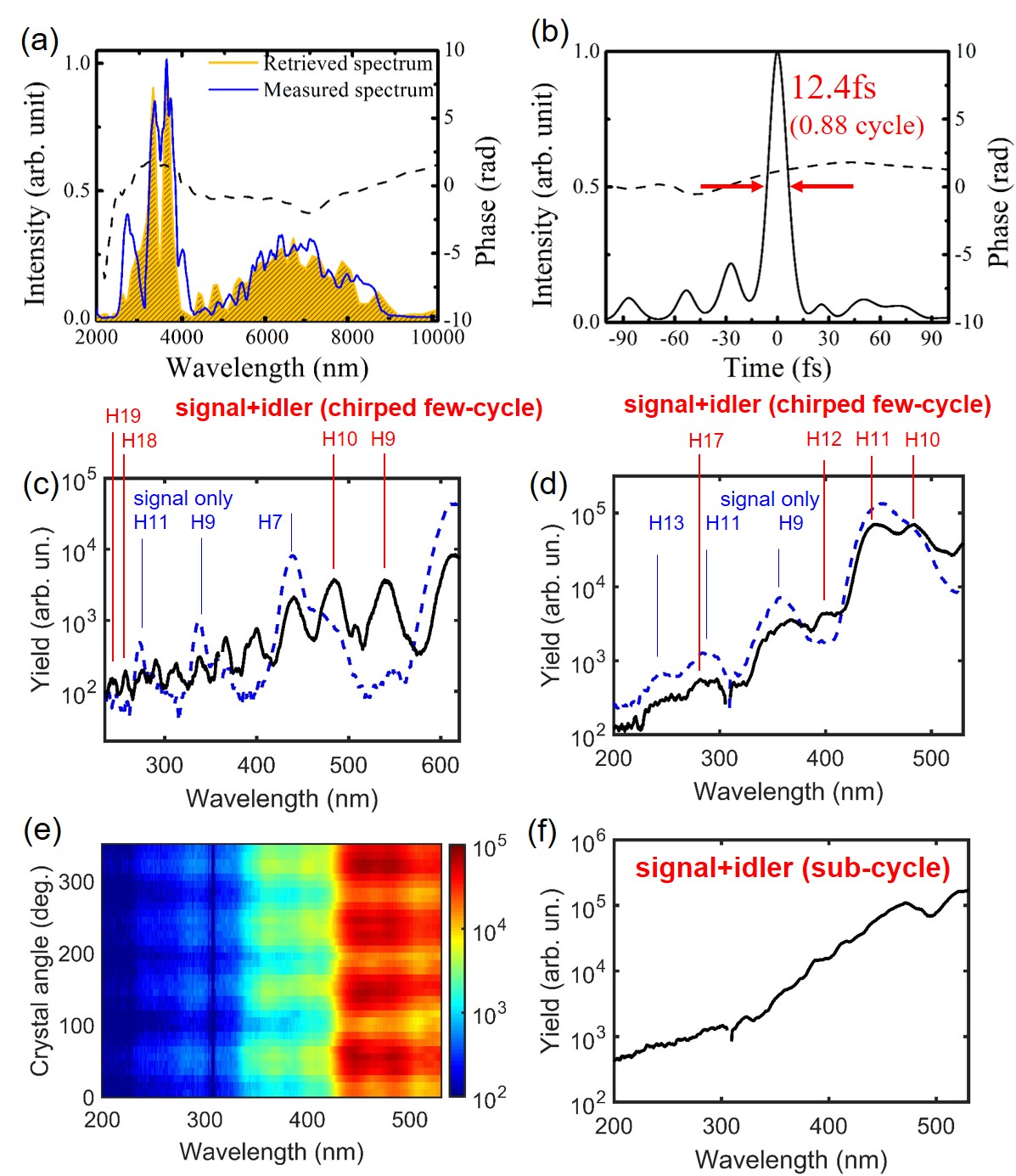
Fig. 2 Retrieved spectral (a) and temporal (b) intensity profiles of the synthesized mid-IR pulse. The dotted curves are the retrieved phase. Harmonic spectra generated in a 200-nm-thick free-standing Si sample (c) and a 500-nm-thick Si sample on a 0.5-mm-thick sapphire substrate (d), driven by chirped few-cycle synthesized pulses. The blue dotted line represents the spectrum generated by only the signal pulse. (e) The angle dependence of the harmonic spectra about the Si axis <001> relative to the laser polarization. (f) The near-continuous harmonic spectrum generated by the synthesized sub-cycle pulse without chirping.
References
[1] G. J. Stein, P. D. Keathley, P. Krogen, H. Liang, J. P. Siqueira, C.-L. Chang, C.-J. Lai, K.-H. Hong, G. M. Laurent, and F. X. Kärtner, “Water-window soft X-ray high-harmonic generation up to nitrogen K-edge driven by a kHz, 2.1 μm OPCPA source,” J. Phys. B 49, 155601 (2016).
[2] K.-H. Hong, C.-J. Lai, J. Siqueira, P. Krogen, J. Moses, C.-L. Chang, G. J. Stein, L. E. Zapata, and F. X. Kärtner, “Multi-mJ, kHz, 2.1-mm optical parametric chirped pulse amplifier and high-flux soft X-ray high-harmonic generation,” Optics Letters 39, 3145-3148 (2014).
[3] Y. Pertot et al., “Time-resolved x-ray absorption spectroscopy with a water window high-harmonic source,” Science 355, 264 (2017).
[4] N. Saito et al., “Attosecond streaking measurement of extreme ultraviolet pulses using a long-wavelength electric field,” Sci. Rep. 6, 35594 (2016).
[5] T. Popmintchev et al., “Bright Coherent Ultrahigh Harmonics in the keV X-ray Regime from Mid-Infrared Femtosecond Lasers,” Science 336, 1287 (2012).
[6] M. Hohenleutner et al., “Real-time observation of interfering crystal electrons in high-harmonic generation,” Nature 523, 572-575 (2015).
[7] H. Liang, P. Krogen, Z. Wang, H. Park, K. Zawilski, P. Schunemann, J. Moses, L. F. DiMauro, F. X. Kärtner and K.-H. Hong, “High-energy mid-infrared sub-cycle pulse synthesis from a parametric amplifier,” Nature Communications, in press (2017). DOI: 10.1038/s41467-017-00193-4.
High field THz Generation and Applications
Many exciting applications depend on the development of a high field, ultrafast terahertz (THz) source. Among these include nonlinear THz spectroscopy [1], and acceleration of charged particles [2,3].
Cascaded optical rectification (OR) is attractive for efficient THz pulse generation because the nonlinear interaction can produce over 100% photon conversion efficiency. Among the materials used for OR, lithium niobate is most promising because it presents high nonlinear coefficient, high damage threshold, low THz absorption, and the absence of two- and three-photon absorption.
However, because the refractive index of lithium niobate between the near-infrared and THz ranges differs by over a factor of 2, collinear phase-matching is not possible. Phase-matching can be fulfilled by the tilted-pulse-front pumping (TPFP) technique [4] in which the diffracted pulse from a grating is imaged onto the lithium niobate crystal. This method has recently produced 400 uJ pulses at relatively high efficiency (0.77%) [3].
According to calculations, the conversion efficiency of OR in lithium niobate using the TPFP technique can be improved by (i) using longer pump pulse duration of ~500 fs to optimize effective nonlinear interaction length [5], (ii) cryogenically cooling the crystal to reduce THz absorption losses, and (iii) optimizing the imaging setup of the grating. These improvements were implemented in our group, resulting in record-high conversion efficiencies [6,7].
Current work in our group involves (1) studying the 2D nonlinear dynamics tilted pulse front pumping, (2) investigating the echelon-based approach to tilted pulse front pumping [8], and (3) exploring methods of high efficiency multi-cycle (narrowband) THz generation.
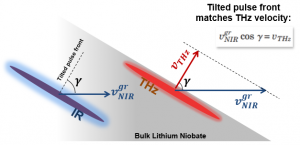
Fig. 1 Tilted pulse front pumping enables phase-matched high efficiency THz generation in lithium niobate.
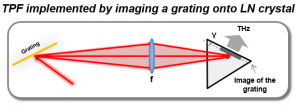
Fig. 2 Tilted pulse fronts are a byproduct of angular dispersion in a beam, which can be induced by diffracting the beam off of a grating and imaging it onto the nonlinear crystal.
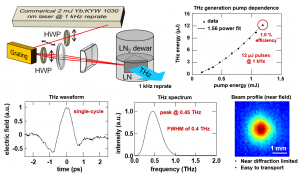
Fig. 3 Our results show single-cycle, diffraction limited THz pulses with high efficiency. Adapted from [9].
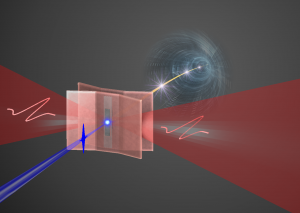
Fig. 4 These single-cycle THz pulses can be used for electron acceleration as shown in this schematic. See [2], [3] and [9] for experimental demonstrations.
References
[1] M. C. Hoffmann, J. Hebling, H. Y. Hwang, K. Yeh, and K. A. Nelson, “Impact ionization in InSb probed by terahertz pump—terahertz probe spectroscopy,” Phys. Rev. B 79, 161201(R) (2009).
[2] E. A. Nanni, W. R. Huang, K-H. Hong, K. Ravi, A. Fallahi, G. Moriena, R. J. D. Miller, and F. X. Kärtner, “Terahertz-driven linear electron acceleration,” Nature Communications 6, 8486 (2015).
[3] W. R. Huang, A. Fallahi, X. Wu, H. Cankaya, A-L. Calendron, K. Ravi, D. Zhang, E. A. Nanni, K-H. Hong, and F. X. Kärtner, “Terahertz-driven, all-optical electron gun,” Optica 3, 1209-1212 (2016).
[4] J. Hebling, G. Almási and I. Z. Kozma, “Velocity matching by pulse front tilting for large area THz-pulse generation,” Opt. Express 10, 1161-1166 (2002).
[5] J. A. Fülöp, Z. Ollmann, C. Lombosi, C. Skrobol, S. Klingebiel, L. Pálfalvi, F. Krausz, S. Karsch, and J. Hebling, “Efficient generation of THz pulses with 0.4 mJ energy,” Opt. Express 22(17), 20155–20163 (2014).
[6] S-W. Huang, E. Granados, W. R. Huang, K-H. Hong, L. E. Zapata, and F. X. K¨artner, “High conversion efficiency, high energy terahertz pulses by optical rectification in cryogenically cooled lithium niobate,” Optics Letters 38, 796 (2013).
[7] W. R. Huang, S-W. Huang, E. Granados, K. Ravi, K-H. Hong, L. E. Zapata, and F. X. Kärtner, “Highly efficient terahertz pulse generation by optical rectification in stoichiometric and cryo-cooled lithium niobate (Invited),” Journal of Modern Optics 10, 868547 (2013).
[8] B. K. Ofori-Okai, P. Sivarajah, W. R. Huang, and K. A. Nelson, “THz generation using a reflective stair-step echelon,” Optics Express 24, 5057-5068 (2016).
[9] W. R. Huang, E. A. Nanni, K. Ravi, K-H. Hong, A. Fallahi, L. J. Wong, P. D. Keathley, Luis E. Zapata, and F. X. Kärtner, “Toward a terahertz-driven electron gun,” Scientific Reports 5, 14899 (2015).

